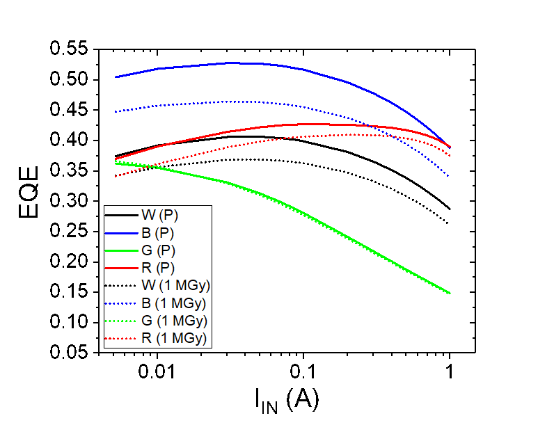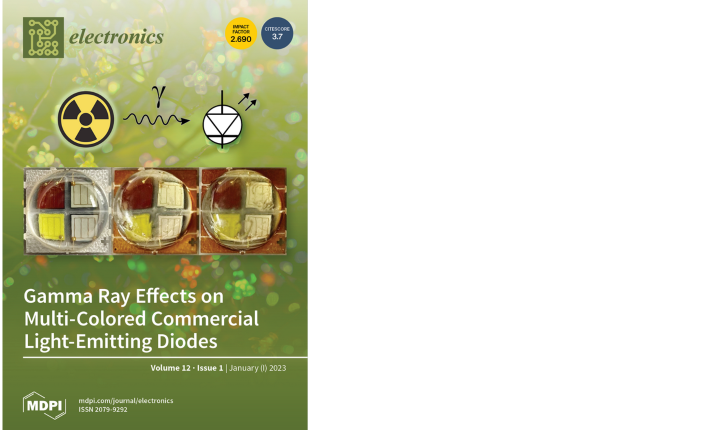Article: Gamma Ray Effects on Multi-Colored Commercial Light-Emitting Diodes at MGy Level
An invited paper recently published by our MOPERE team in the special issue ‘Radiation Tolerant Electronics, Vol. III’ of the journal Electronics was selected amongst 252 articles to appear on the cover of their January 2023 issue (Vol. 12, Issue 1). In the article, the most recent results regarding the effects of radiation on Light-Emitting Diodes are presented and discussed. The work was done in collaboration with the Direction des Applications Militaires of the Commissariat à l’Énergie Atomique et aux Énergies Alternative (CEA DAM).
Within the context of a constantly growing optoelectronic market, an increasing number of optoelectronic devices are being studied for applications in radiation-rich environments. Among them, the behavior of light-emitting diodes (LEDs) under irradiation has not yet been fully investigated, due to the complexity of radiation effects in the very dense multilayer architectures constituting an LED. Indeed, an LED includes a high number of layers with very different radiation-induced responses (e.g. materials, quantum wells, reflective layers and lenses). In this paper, an experimental approach is used to investigate the evolution of the optical properties of commercial LEDs as a function of their exposure to γ-rays, up to the large total ionizing dose of 2 MGy(air).
The studied devices include four LEDs of different colors in the same package: red, green, blue and white. The purpose of this combination is to design a white light source in which the tone and warmth can be controlled. The presence of the four diodes in the same package allows a direct comparison of the responses of different technologies, as the proximity between the diodes ensures the uniformity of their irradiation conditions.
The main figure of merit investigated in this work is the external quantum efficiency, providing an overall estimate of the inefficiencies inside an LED, from the electrons injected to power it on to the photons which exit its lens. The efficiency of all tested LEDs was reduced due to radiation, especially for red ones. The loss in efficiency can be explained by a radiation-induced increase in the number of traps inside the diodes. Red LEDs’ higher radiation sensitivity has been observed before, and it can be explained by the different technologies and materials used to achieve these emitted wavelengths.
Another important outcome of the study relates to the radiation stability of the opto-mechanical properties of the lens encasing the device. The collected results show no significant effect on these properties following the lenses’ irradiation. By contrast, exposition to γ-rays compromised their mechanical properties, with some lenses breaking or at least showing signs of structural weakness.
This study represents one of the first published works on the radiation resistance of commercial LEDs. The collected results and used methodologies pave the way for future investigations on radiation tolerant LEDs, which will become increasingly necessary for high-radiation applications.

Figure 1 above: The LED structure in different conditions.
The unirradiated sample is shown in its OFF (a) and ON (b) state.
The LEDs depicted in the two rightmost pictures have been irradiated
at the reported doses of 1 MGy (c) and 2 MGy (d).

Figure 2 above:
EQE vs. current of a sample before (solid lines) and after (dashed lines)
1 MGy of absorbed dose divided by color.
Abstract
Light-emitting diodes (LEDs) are of interest for implementation in radiation environments, such as part of illumination systems of radiation-tolerant cameras able to provide images at high doses (>MGy). It is then mandatory to characterize the radiation effects on all of the LED key properties exploited for such applications. To this aim, the evolution of the optical properties of commercial LEDs after they have been exposed to γ-rays, up to total ionizing dose (TID) levels of 2 MGy(air) at room temperature, is discussed. The devices under test include four LEDs of different colors (red, green, blue and white) in the same package. This allows a direct comparison between the responses of the different structures and technologies, as the proximity between the diodes ensures the uniformity of their irradiation conditions. The radiation effect on the electron–photon conversion mechanisms inside these LEDs is investigated through the evolution of their external quantum efficiency (EQE) vs. current characteristics. The spectral emission pattern of LEDs after irradiation at different dose levels is then characterized to estimate the TID effects on the lens which surrounds the LED package. The presented results show a monotone radiation-induced EQE decrease as a function of the TID, especially in the red LEDs. For the tested red LEDs, the EQE decreased up to 78% after a TID of 1 MGy when they were OFF during irradiation, and up to 8% when they were ON during irradiation. A visual inspection of the devices after irradiation shows a mechanical degradation of the lens shared among the four diodes. However, the emission pattern analysis does not show any significant radiation-induced changes in the optical properties of the lens. Based on these results, it appears possible to design LED-based illumination systems able to survive to MGy dose levels that can be integrated as subsystems of radiation-hardened cameras.
Read the full article here

